
Karamjeet Singh Judge VC was an Indian recipient of the Victoria Cross, the highest and most prestigious award for gallantry in the face of the enemy that can be awarded to British and Commonwealth forces.

The Ashoka Chakra is India's highest peacetime military decoration awarded for valor, courageous action, or self-sacrifice away from the battlefield. It is the peacetime equivalent of the Param Vir Chakra (PVC) and is awarded for the "most conspicuous bravery or some daring or pre-eminent valour or self-sacrifice" other than in the face of the enemy. The decoration may be awarded either to military or civilian personnel.
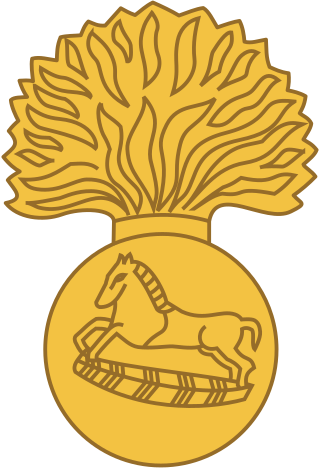
The Grenadiers is an infantry regiment of the Indian Army, formerly part of the Bombay Army and later the pre-independence British Indian Army, when the regiment was known as the 4th Bombay Grenadiers. It has distinguished itself during the two world wars and also since the Independence of India. The regiment has won many battle honours and gallantry awards, and is considered to be one of India's most decorated regiments with three Param Vir Chakra awardees in three different conflicts.
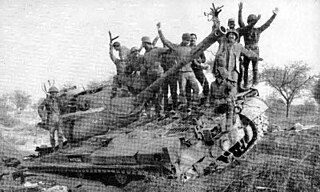
The Battle of Basantar, also known as the Battle of Shakargarh or Battle of Barapind, was one of the vital battles fought as part of the Indo-Pakistani War of 1971 in the western sector of India. The Indian troops won a hard-fought battle that secured this area in the Punjab/Jammu sector. The name Battle of Basantar actually encompasses the entire gamut of battles and skirmishes fought in the Shakargarh sector.
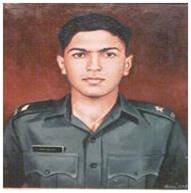
Second Lieutenant Arun Khetarpal PVC was an Indian military officer and a posthumous recipient of India's highest military decoration, the Param Vir Chakra, which he was awarded for his valour in face of the enemy. He was killed in action in the Battle of Basantar during the Indo-Pakistan War of 1971 where his actions earned him his honour.
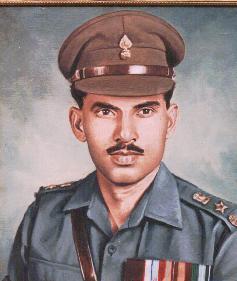
Colonel Hoshiar Singh Dahiya, PVC was an Indian military officer and a recipient of India's highest military honour, the Param Vir Chakra, for his gallantry during the Indo-Pakistani war of 1971.
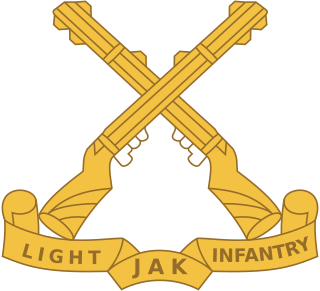
The Jammu and Kashmir Light Infantry is an infantry regiment of the Indian Army. The regimental center is in Srinagar's Airport Complex at Awantipora with a winter setup near Jammu. Its regimental insignia consists of a pair of crossed rifles. The regiment mostly consists of volunteers from the state of Jammu & Kashmir and ethnic groups from the state. The Jammu and Kashmir Light Infantry is considered to be one of the most decorated regiment of the Indian army having won 1 Param Veer Chakra and 3 Ashok Chakra. Naib Subedar Chuni Lal of the 8th battalion Jammu and Kashmir Light Infantry is one of the most decorated personnel of the Indian Army.
Ghatak Platoons are special operations capable reconnaissance platoons present in every infantry battalion of the Indian Army. Ghatak is a Sanskrit word meaning "killer" or "lethal". Their name was given to them by General Bipin Chandra Joshi. They act as shock troops and spearhead assaults ahead of the battalion.

The 16th Light Cavalry is a regiment of the Armoured Corps, a primary combat arm of the Indian Army. Prior to India gaining independence from the British in 1947, it was a regular cavalry regiment of the British Indian Army. It was formed in 1776 and is the oldest armoured regiment raised in India. The 16th Light Cavalry saw service in a number of conflicts ranging from the Second Anglo-Mysore War in 1781 to World War II. It has a number of battle honours including "Punjab 1965" earned during the Indo-Pakistani War of 1965.
Dighal is a village in Beri tehsil in Jhajjar district of Haryana state in north India. It falls under the Rohtak Division. It is the largest village in terms of population in a single panchayat in Haryana.
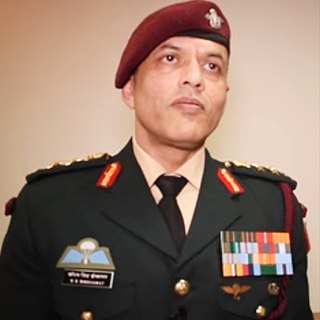
Brigadier Saurabh Singh Shekhawat, KC, SC, SM, VSM is an Indian Army officer of the 21 Para (SF) and an avid mountaineer. He is one of Indian Army's most decorated officers, with one war-time gallantry award and two peace-time gallantry awards to his name.

Colonel Vasanth Venugopal, AC was an Indian Army officer. He was the commanding officer of the 9th battalion, Maratha Light Infantry. On 31 July 2007, he was Attained veergathi in action while preventing heavily armed infiltrators from crossing the India-Pakistan border at Uri, Jammu and Kashmir. As a result he was posthumously awarded the Ashoka Chakra, India's highest military decoration for peacetime gallantry.
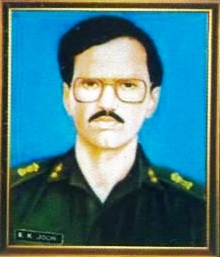
Major Rajiv Kumar Joon, AC, SC was a highly decorated Officer in the Indian Army. He was posthumously awarded the Ashoka Chakra, India's highest peace-time military decoration. He was previously decorated with the Shaurya Chakra, the third-highest peacetime military decoration.

Lieutenant General Raj Mohan Vohra, PVSM, MVC was a General Officer of the Indian Army. He was awarded the Maha Vir Chakra for his bravery and leadership in the Battle of Basantar during the Indo-Pakistani War of 1971.

Harsh Udai Singh Gaur was an Indian military officer posted as commanding officer of 10 Bihar Regiment.
Colonel Balwan Singh Panghal MVC is a decorated Indian Army officer who was awarded the Maha Vir Chakra for his courage in leading the successful assault to capture Tiger Hill during the 1999 Kargil War.
Brigadier Rai Singh Yadav, MVC was an officer in the Indian Army notable for his participation in the Nathu La and Cho La clashes 1967. He displayed exemplary courage and leadership during the clashes, for which he was awarded the Maha Vir Chakra, India's second highest military decoration. He is also known as the Tiger of Nathu La.
Lieutenant General Ved Prakash Airy, MVC was an officer of the Indian Army, who served with the 3 Grenadiers. He is best known for his participation in the Battle of Basantar, one of the major battles of the Indo-Pakistani War of 1971, where he was awarded the Maha Vir Chakra, India's second highest award for gallantry in the face of the enemy.
Brigadier Amarjit Singh Bal, MVC was an officer of the Indian Army, who served with the 17 Horse. He was awarded the Maha Vir Chakra, India's second highest award for gallantry in the face of the enemy, during the Battle of Basantar in the Indo-Pakistani War of 1971.
101 Field Regiment is part of the Regiment of Artillery of the Indian Army.














